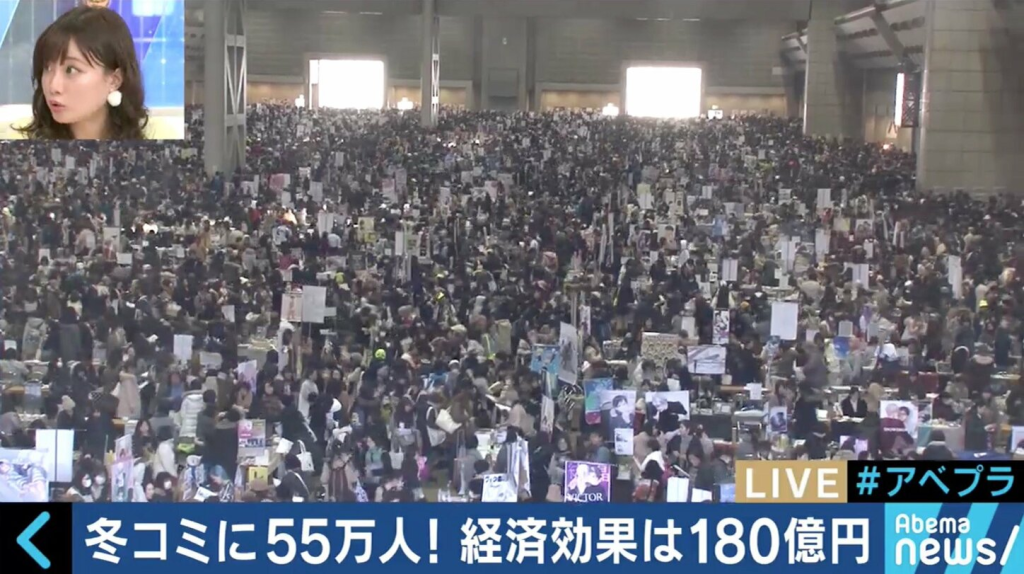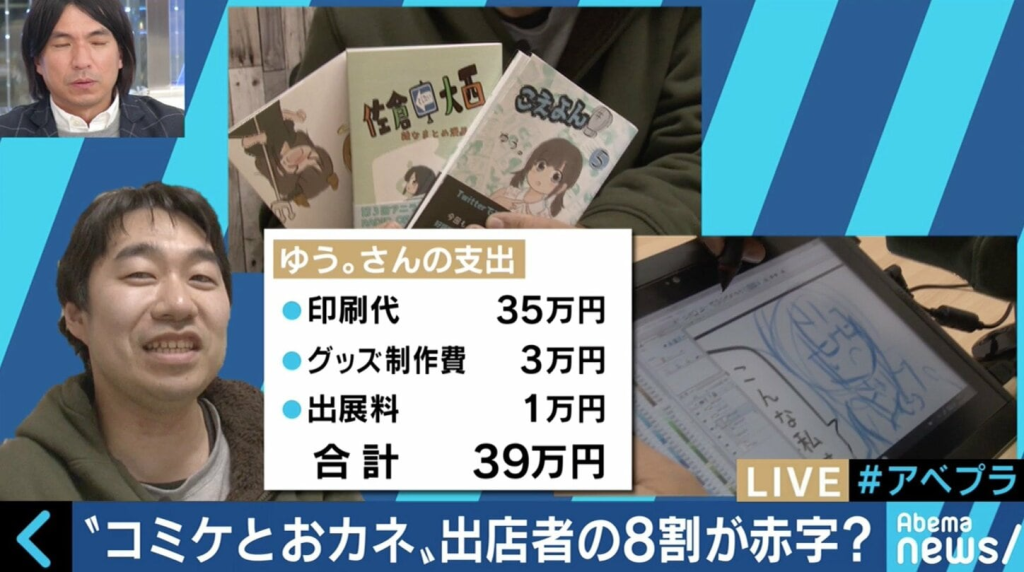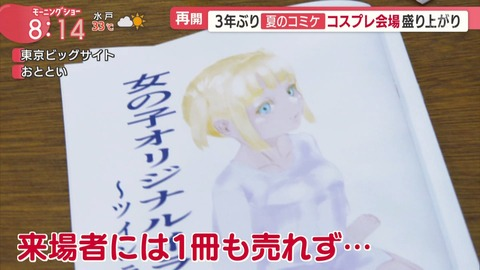

On August 13 and 14, 2022, the commemorative 100th Comiket (Comic Market) happened in Tokyo, bringing in approximately 170,000 attendees.
Back in 2018, Abema News reported that the economic effect brought by Comiket was estimated to be about 18 billion yen (approximately US$ 124.7 million) in pre-pandemic times.
After 2007 and before the pandemic era, each Comiket brought over 500,000 attendees. C96 and C97 in 2019 brought in over 700,000 attendees, a record high. (Source: Comitteru)
While the number of attendees has significantly decreased due to COVID-19 precautionary measures, Comiket remains the most influential doujin event in Japan.
It is a common goal among doujin artists to grasp the chance to be sellers at Comiket. Doujin artists, especially young newbies, may dream of making it big and hitting the jackpot with their sales, considering how huge the market is for the event.
But are their goals realistic or merely pipe dreams?
Most artists don’t make money at Comiket
In December 2011, the official Comic Market Preparatory Committee and Content Research Team published a statistical report to commemorate the 35th year of Comiket.
This report stated that most circles attending Comiket participated in the event, expecting to be in the red. In fact, over 60% of the circles were making deficits.
One may wonder that perhaps this percentage may have decreased over the years along with the growth of the event.
In 2015, AERA magazine reported that approximately 60% of the Comiket-participating circles were in the red.
We could not find a more recent report from a credible source regarding this percentage after 2015, but it is likely that the percentage of authors in deficit has not improved.
Naoki Satomi, the PR officer of the Comic Market Preparatory Committee, has been quoted saying, “Of course, there are people who make a profit [from the event]. But it’s not that easy to make money.” (Source: AERA)
Costs of being at Comiket
Chiba Asahi, a veteran doujin author who has been in the business for over 29 years, noted that when an author participates in an event, they must think about five main costs. These five costs are the event booth fee, printing fee, logistical costs (shipping and handling of printed works to the event), transportation fee (including hotel costs if you’re planning to stay in the event area for a few days), and booth display cost (if you want to decorate your booth area to make it flashy). (Source: Anman)
These costs quickly add up, and unless you’re an author with ample financial resources, you will have to calculate your budget very carefully so that your expenses don’t overwhelm you.
Actual examples of cost versus profit from people who have attended Comiket
Let’s have a look at two participants from Comiket 95 in the winter of 2018 as reported on Abema News.

Example of an author being in the red
For this young man named Fukazawa, it cost him a total of 22,000 yen (approximately US$152) to print his doujin works and for booth fees.
After 5 hours, he had only sold enough to make 2700 yen (approximately US$18.71) and was not turning a profit.

Example of an author turning a profit
This author, named Yuu, spent a whopping total of 390,000 yen (approximately US$2703) for printing his works, manufacturing merch, and booth fees from his pocket.
However, because he was a popular author, his fans rushed to his booth, and by the third hour after the start of the event, he had nearly sold out all 750 copies of his books.
By that time, Yuu reported that he had made around 100,000 yen (approximately US$693) in profit and stated that he would use the money for the next Comiket that he could attend.
Only a handful makes a profit at Comiket
According to an article in AERA from 2015, only 10% of the circles in Comiket make an annual profit of 200,000 yen (approximately US$1386).
This small handful of profitable circles is commonly thought to be the 壁サークル (kabe circles), which translates to “wall circles.” Kabe circles get the name from the fact that they are given advantageous booth designation in the Comiket event hall due to their popularity. The authors of these kabe circles are big shots in the doujin world. Some of them are so popular their copies sell out immediately, leaving some fans disappointed that they couldn’t get a book from their favorite authors. (Source: Ichi-Up)
But it takes years of endeavor and luck to become a kabe circle author. Most artists do not make it there.
In recent times, authors have also been plagued with illegal uploads of their works. Not only that, there have been conniving scalpers who buy works at Comiket and sell them online for more than double the price the author has sold for. Obviously, the profits these vultures make do not go back to the authors. Authors must combat these external negative forces as well, especially if they are popular artists. (Source: Abema News)
If authors aren’t making profits, why do they even bother attending Comiket?
世界最大同人誌即売会、コミケットでは参加する7割前後のサークルは印刷費も回収できないほど売り上げが少ない。それでも繰り返し参加しているのは似た趣味の方々と時間と空間を共有したり、数少なくとも本当に好きな人に対して作品を提供できる楽しみがあります。ネットではなかなか再現しにくい。
— 兼光ダニエル真 冬コミ新刊委託中 (@dankanemitsu) August 20, 2021
Renowned translator Dan Kanemitsu (whose notable translations include the new Evangelion feature film trilogy) explains that the reason why authors repeatedly attend Comiket, despite the majority of them resulting in a deficit, is due to the nature of the event.
Kanemitsu explains that being able to share time and space with like-minded people and being able to provide truly passionate fans with the fruit of your labor, regardless of how small the number of copies you make, are enjoyable elements of the doujin events.
Aiko Somemiya on her Comiket experience
Writer and manga scenario researcher Aiko Somemiya, who has attended multiple Comiket herself, shared her perspective in her 2017 editorial on Tokyo Keizai Online. She included details of her own experience at the event, noting that she had over 30 self-published titles for the event, but only 2 to 3 titles had sold over 100 copies even though she had spent countless hours laboring over each of the projects. Somemiya explained that regardless of whether they are making sales or not, people come to Comiket from their overwhelming desire to show the world their creative endeavors. She explains the joy of materializing the idea you have, having other people buy your works and emphasize with you, cannot be measured by monetary profits or losses.
In the aforementioned official Comiket report from 2011, Comiket delved into the motives of the event participants. 41.5% of the participants answered that their motive was “Having other people see my works.” This was the number-one answer. The second top motive (21/3%) was “The fact that Comiket has a festive atmosphere.” And the third top answer (13.1%) was, “Being able to see friends and acquaintances that I can’t see usually.”
An anonymous author shares his Comiket experience
In a 2021 interview, an anonymous doujin author who has participated at multiple Comiket said that while event-related expenses run him down into deficit often, the reason why he continues to attend Comiket as a seller is that he sees the values in the event that goes beyond money.
He says that the time he has spent with fellow doujin authors who come from different backgrounds and cities all over Japan, swapping each other’s doujin works, giving encouragement to one another about their publications, and passionately discussing the characters that they love is incomparable to anything. He adds that for him, being able to connect with other people is the most important factor.


On Morning Show, a Japanese morning news variety program, an anonymous first-time author was interviewed at Comiket 100 in August 2022.
While he sold no copies at his booth, he said that he was “incredibly satisfied” with his experience as a new seller.
In conclusion
In this long-running event, there is a strong culture for participants to view it as a place of meeting others rather than a place of making a profit. The joy of warm camaraderie with other participants is at the foundation of the Comiket experience.
Of course, for some authors who are popular, Comiket may be a great time to rake in money, but such an opportunity is reserved for only a tiny number of people.
While they may not make many sales, Comiket can also serve as a marketing chance for authors. The event gives a place for authors to interact with potential readers. The potential readers can get to know the author in a more personal way compared to online exchanges.
Each event can also serve as a learning experience. Participants can reflect on their activities during Comiket to analyze what they did right or wrong and improve for next time.
Ultimately, the “making money” aspect of Comiket is minor to the participating artists. It is the human connections with fellow authors and attendees that are most precious to them.
Other:
Did you know we have a catalog of FREE-TO-READ doujinshi and a collection of works available for 99 CENTS each? Check them out!

If you enjoyed this article, you can support us by buying our officially localized English Doujinshi at our Irodori Comics Store! Works are uncensored and DRM-Free for you to keep!
When you buy works on our website, up to 60% of the selling price goes directly to the artists as royalties!
Read more news articles here.













